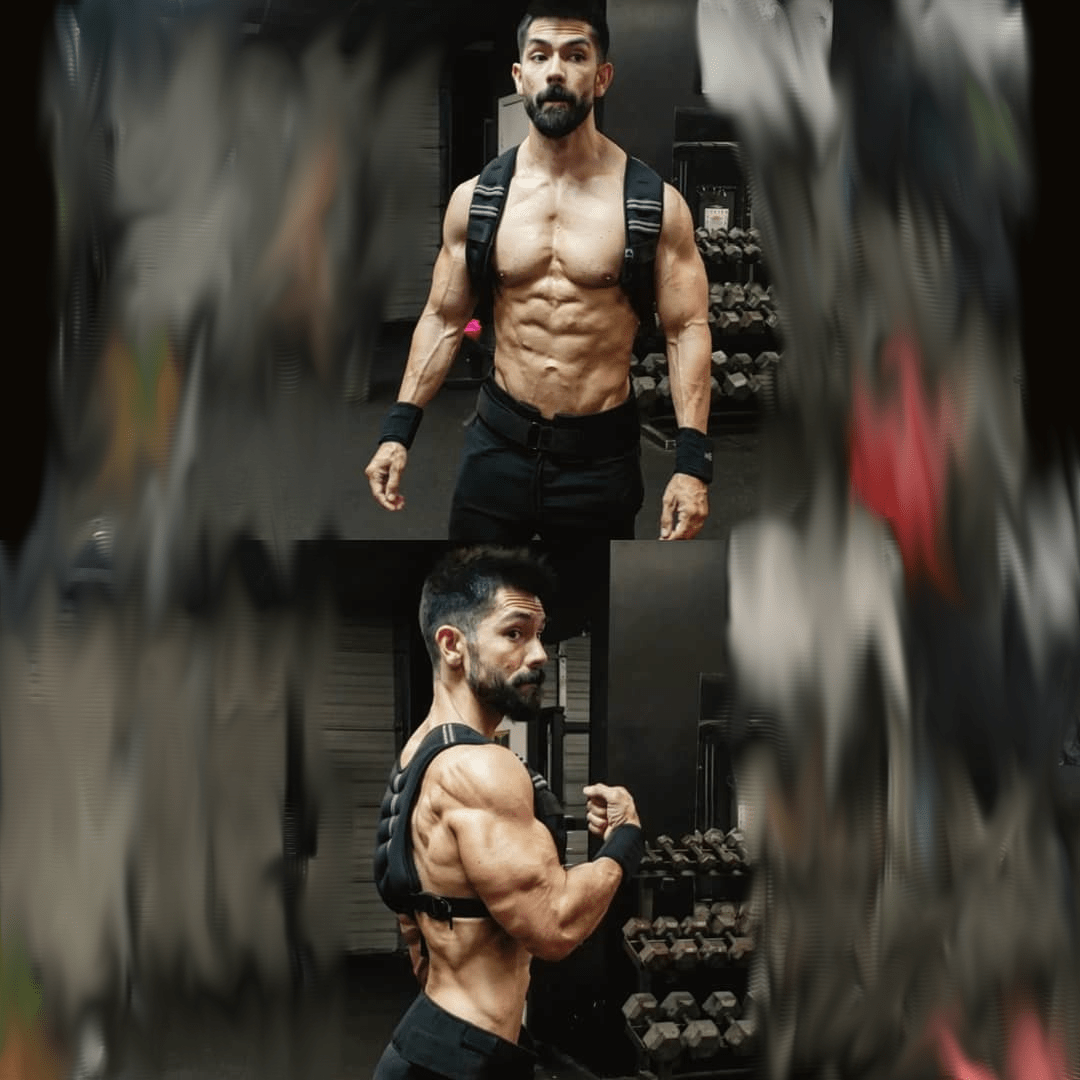
The Use of Weighted Apparel During Contest Prep: The Science and Practical Application
Rarely do I consider any technique a "game-changer" when it comes to fat loss. The science of fat loss and muscle preservation hasn't changed much in the past few years. We still know you need to consume a lot of protein, keep deficits small to reduce muscle loss, maintain weight training volume and intensity to preserve muscle, rely mostly on minimally processed foods to maintain satiety, and increase low intensity activity like NEAT. However, the use of weighted apparel may be one of those factors that can be considered a "game-changer." Let's delve into the science of it, how one of my coaching clients used it, and how you can apply it to your own prep.
Table of Contents
- Key Takeaways
- A Case Study: Eric Lee Salazar
- The Science
- Practical Application and Limitations
Key Takeaways
- The use of weighted apparel during contest prep may help reduce metabolic adaptation, decrease hunger, maintain muscle in the legs, and decrease the negative symptoms of contest prep.
- Weighted apparel may work by helping to maintain NEAT and total daily energy expenditure, reduce appetite, allow fat loss in a state of high energy flux, and stimulate the "gravitostat".
- The best way to implement it is to start with a small deficit, then gradually add external weight as you lose weight for a contest.
- It may not be practical for everyone, and its successful use will depend upon an individual's circumstances.
- It will work best when combined with frequent standing/walking. It may not work very well for individuals who sit most of their day.
A Case Study: Eric Lee Salazar
Recently, my coaching client Eric Lee Salazar embarked on an experiment during his preparation for a couple bodybuilding shows. During his prep, he wore a weighted vest to replace the weight he was losing while dieting. He started his prep at a body weight of 165 lbs on 2300 calories per day. This amounted to about a 300 calorie per day deficit. The aim was to lose about 0.5% of body weight per week, as this rate of loss is associated with superior lean mass retention.
Here is a graph of Eric's progress from November to April.
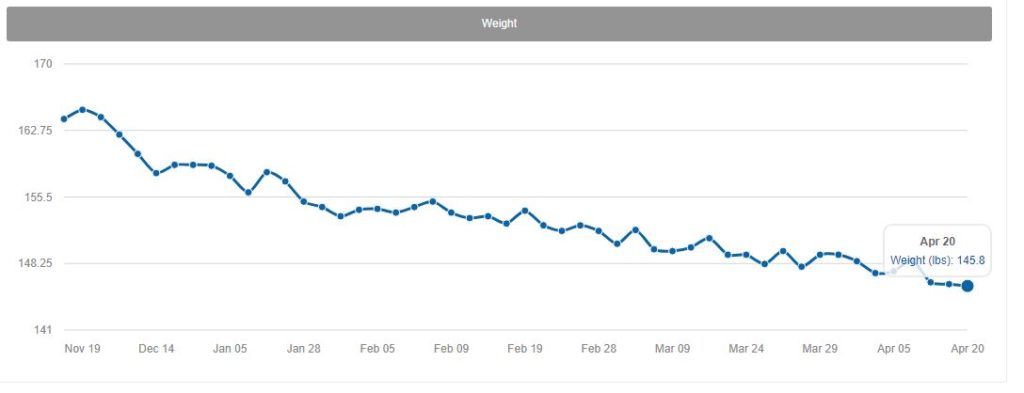
Over 15 weeks, Eric lost 19 lbs, which ended up to be about 1.2 lbs per week or 0.7% of body weight. While this was a bit faster than planned, it was still within the 0.5 to 0.7% loss rate that is associated with optimal lean mass retention.
During this time, Eric did not progressively reduce his calorie intake as he lost weight. Rather, he kept his calorie intake constant at 2300 and his daily step count constant at 9500, but artificially added body weight through the use of weighted apparel. During the first 4 weeks, he did not add any weighted apparel.
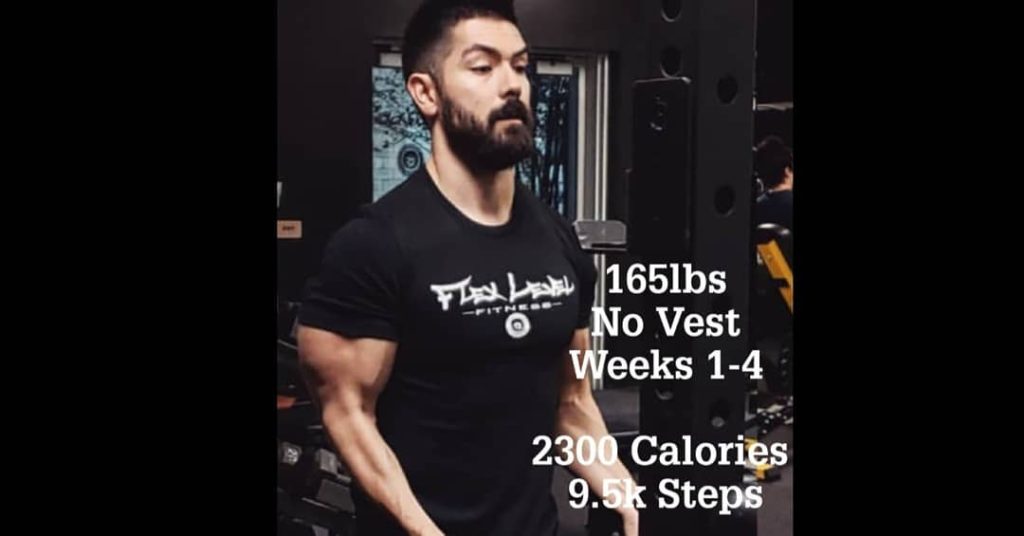
At 4 weeks, Eric was down to about 158.5 lbs, which was a 6.5 lb loss. He then added a 12 lb weight vest to replace his lost body weight, bringing his body weight up to 170.5 lbs, about 5 lbs heavier than his initial starting weight. He wore the vest every day for the vast majority of the day.

He kept his calories at 2300 and his step counts at 9500. He continued wearing the vest through week 8.
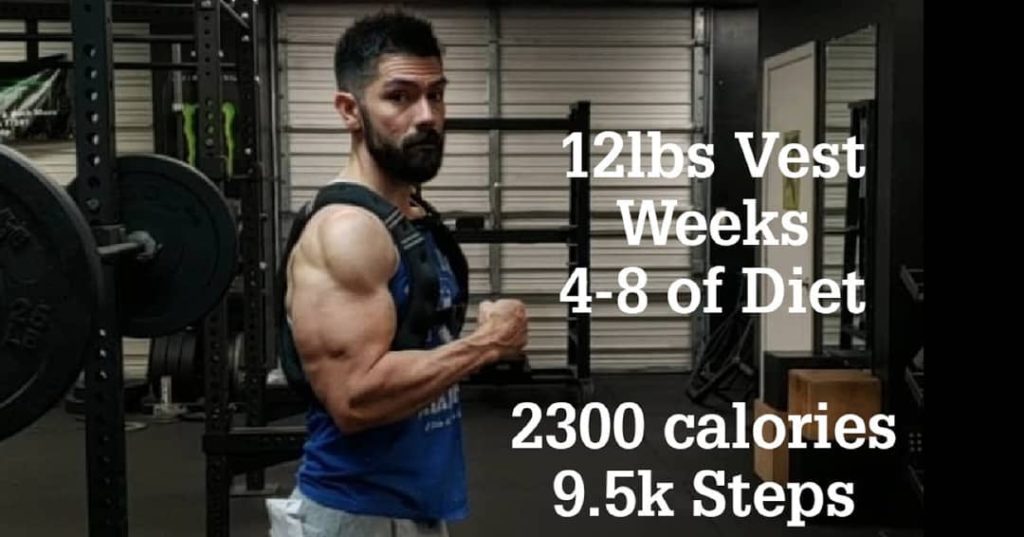
During weeks 8-12, Eric switched to a 20 lb weighted vest. He continued to keep his calorie intake at 2300 and step count at 9500. At 12 weeks, Eric was down to 150 lbs. With the 20 lb weighted vest, his artificial weight was at 170, which was about the same as it was for weeks 4-8. Thus, Eric was keeping his "fake" body weight constant, while his true body weight sans the apparel continued to drop.
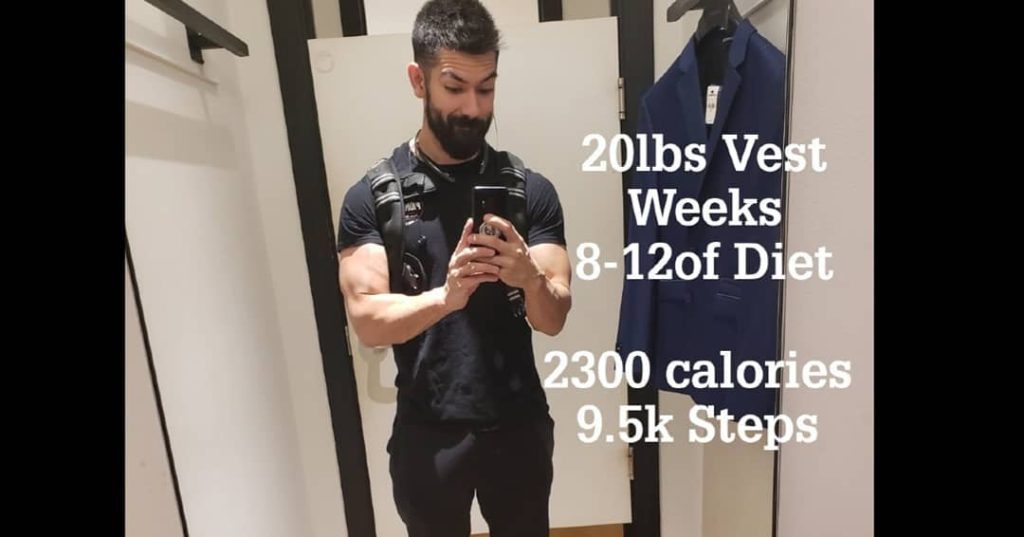
During weeks 12-16, Eric added 4 lb ankle weights along with the 20 lb vest. By the end of this phase, Eric's true body weight was down to 146 lbs. With the apparel, his artificial body weight was up to 174 lbs...almost 10 lbs heavier than his initial starting body weight of 165. Calorie intake and steps continued to remain constant.
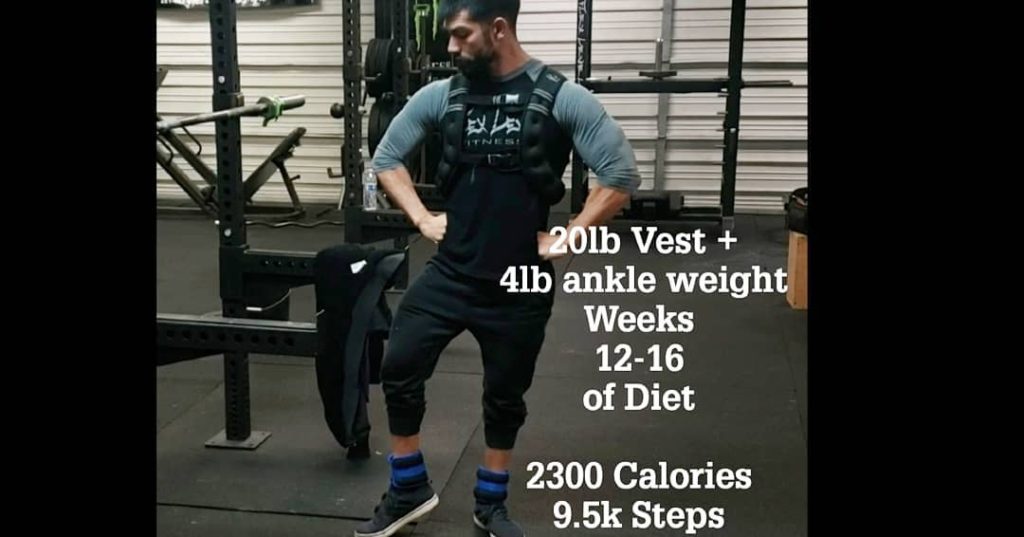
After 16 weeks, Eric upped the ante and added more artificial weight, bringing his total weight to 181 lbs.
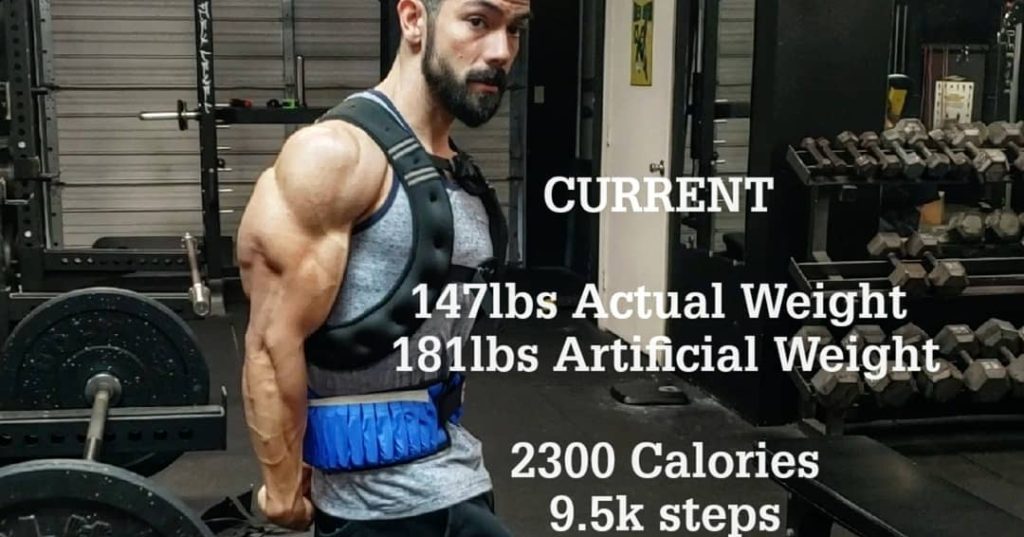
During all this time, Eric did not suffer the typical adverse symptoms that one might experience during a contest prep. He did not get brain fog, extreme hunger, extreme fatigue, etc, despite losing 20 lbs of body fat. He also said he maintained his leg size and strength better due to having more body weight to walk around on. Here is a video where he describes the experience.
Here's another video where Eric, Eric Trexler, and I discuss Eric's experience.
Eric got shredded using the weighted apparel, and won his contest, without experiencing the classic symptoms that competitors typically get when achieving such low body fat. In fact, Eric has reported that it was the easiest prep he's ever had.

Without the vest, Eric would've been normally consuming 1400-1500 calories per day at this stage. Yet, he was still consuming 2300.
Eric then had his sight on NPC Nationals in Las Vegas. We continued with the weighted vest protocol. Eric continued to keep a high total external body weight. Close to the show we did drop his calories to around 1650, but only for a short time (about 3 weeks). This was still a higher calorie intake than what he had typically used for past preps. We increased calorie intake the week of the show to eliminate any issues with diet-induced edema. Eric won the show and got his IFBB Pro Card.

As lean as Eric was, he didn't have any issues with binges, and didn't have nearly the food obsession that he had had with past preps.
So, the question becomes as to why the weighted apparel worked well. Let's delve into the science of it all.
The Science
There are four primary reasons why the use of weighted apparel can work well for competitors in contest prep:
- Maintain non-exercise activity thermogenesis (NEAT) without needing to increase movement
- Maintain total daily energy expenditure without needing to increase exercise
- Establish a calorie deficit in a high energy flux state rather than low energy flux state
- Use the "gravitostat" to your advantage
Let's address each one individually.
Maintain Non-Exercise Activity Thermogenesis (NEAT) Without Needing to Increase Movement
I have written extensively in the past on the importance of NEAT to fat loss. NEAT refers to the energy you expend in activities of daily living. It includes everything from walking around to fidgeting to maintenance of posture. It makes up the majority of activity energy expenditure in most people.
As you lose weight, your NEAT goes down. Part of this is simply because you have less body weight to carry around. If you were doing 10K steps per day with 165 lbs on your frame, and then you are now doing 10K steps with 145 lbs on your frame, you are going to be expending less energy while walking.
To give you an idea of how much less energy you will expend while walking with less body mass, we can use the ACSM walking equations to estimate energy expenditure. If a 165 lb (75 kg) person walks at 2 mph (53.6 m/min, the typical pace most people walk at) on a level grade, that gives an oxygen consumption (the amount of oxygen you use to produce energy aerobically) of:
[53.6 x 0.1] + 3.5 = 8.86 ml/kg/min
To convert this to an energy expenditure, we multiply it by body weight (75 kg in this case), then divide it by 1000 to convert to L/min, then multiply by 5 to get calories per minute.
((8.86 x 75) / 1000) x 5 = 3.32 calories per minute
Now, let's say you have lost 20 lbs and are now down to 145 lbs (65.9 kg). The estimated energy expenditure is:
((8.86 x 65.9) / 1000) x 5 = 2.92 calories per minute
This difference may not seem like much, but let's say your total time spent walking throughout the day is 4 hours (obviously not all at once...this is cumulative through all your waking hours, and includes even very short bouts of walking). At 165 lbs, you will expend 797 calories. At 145 lbs, you will expend 700 calories. Thus, you are expending 100 calories less per day for the same amount of walking, and this does not include all the other non-exercise activity during your day.
Thus, by using weighted apparel to replace lost body weight, you prevent this decline in NEAT. In the above example, if you are wearing 20 lbs of weighted apparel, your walking energy expenditure will remain at 797 calories.
Maintain Total Daily Energy Expenditure Without Needing to Increase Exercise
Similar to the decline in NEAT, there is a decline in total daily energy expenditure (activity + resting metabolic rate + thermic effect of feeding) with weight loss. Again, this is partly due to having less body mass. In fact, we can estimate the impact on energy expenditure of the reduction in body mass using Kevin Hall's models.
Let's use Eric's numbers to illustrate. Using his original body weight (165 lbs), height (5'7"), age (35), and physical activity factor of 1.6, Kevin's models give us an energy expenditure of 2631 calories per day. If we change the body weight to 145, the models give us an energy expenditure of 2486 calories per day, which is a difference of nearly 150 calories per day. To make up this energy expenditure difference in terms of exercise rather than using weighted apparel, Eric would need to run at 5 mph (a jogging pace) for 17 minutes each day at his new body weight of 145.
Remember, too, that Eric pushed the body weight by artificially elevating it to 181 lbs. At 181, Eric's estimated energy expenditure is 2747 calories per day, versus 2486 at 145 lbs. This gives an energy expenditure difference of 261 calories per day! Eric would need to do nearly 30 minutes of jogging each day at 145 lbs to make up for this difference in total daily energy expenditure without the weighted apparel.
Thus, the weighted apparel allows for the maintenance of total daily energy expenditure without having to increase exercise volume or do extra cardiovascular exercise. This can have two advantages. First, cardio may have an interference effect with strength training; thus, you can avoid this effect by using weighted apparel rather than additional cardio. Second, cardio during contest prep is added exercise volume within the context of an energy deficit, low body fat, and simultaneous weight training. This increases the possibility of overtraining, especially given some of the adverse changes in hormones that occur during contest prep. Weighted apparel represents an alternative method for maintaining or increasing energy expenditure in a very low intensity fashion, without needing to resort to additional exercise volume which may exacerbate some of the negative effects of contest prep.
Establish a Calorie Deficit in a High Energy Flux State Rather than Low Energy Flux State
During the traditional contest prep, you lose weight when you first establish an energy deficit (typically through diet, but sometimes additional cardio as well). However, as you lose weight, your total daily energy expenditure decreases. This is not only due to loss of body mass, but also due to adaptive thermogenesis (where your body tries to conserve energy by decreasing resting metabolic rate and NEAT). Thus, the size of your energy deficit progressively decreases, until you reach a new state of equilibrium where energy intake matches energy expenditure.
We can illustrate this using Kevin Hall's Body Weight Planner. If we put in Eric Lee Salazar's data, use the "Lifestyle Change" feature of the Planner, and put in a calorie intake of 2300 calories per day, it gives us a graph of projected body weight over time. You can see how it doesn't go down in a linear fashion. Rather, the rate of weight loss continues to slow down as time goes on, so that it produces a curve that starts to level off as you get closer to equilibrium.
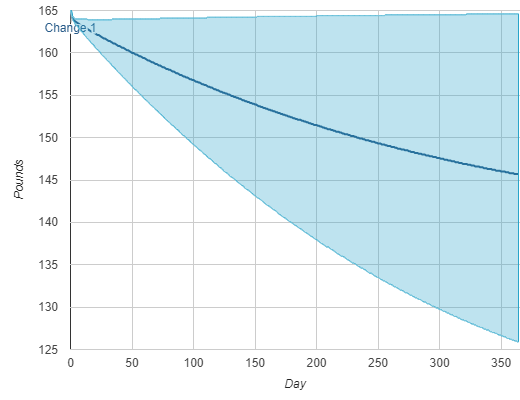
The rate of weight loss slows down because the energy deficit shrinks due to the loss of body mass and adaptive thermogenesis. This graph shows how the difference between energy expenditure (2631 calories per day) and intake (2300 calories per day) shrinks to less than 100 calories as Eric gets close to 145 lbs.
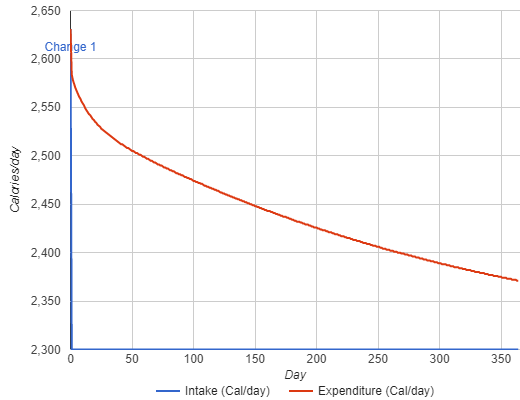
For Eric to continue to lose at a rate of about 1 lb per week, and not experience this slowdown in weight loss, he would need to progressively decrease his calorie intake as he lost weight to sustain the energy deficit. After 1 month, Eric's estimated energy deficit shrinks from approximately 300 calories per day to 200 calories per day.
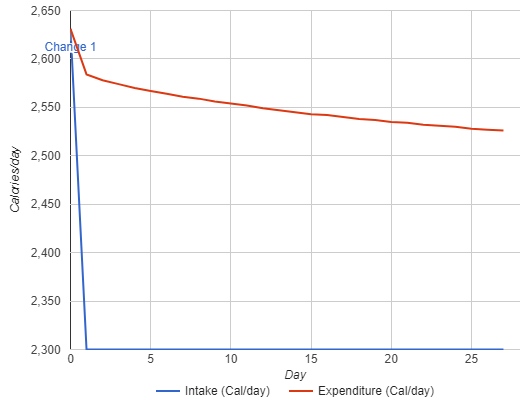
Thus, Eric would need to decrease calorie intake to 2200 after 1 month to sustain his rate of weight loss. If Eric wanted to reach 145 lbs in 16 weeks (112 days), he would need to consume 1900 calories per day.
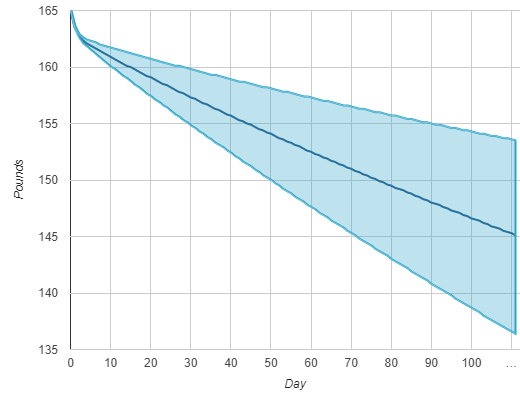
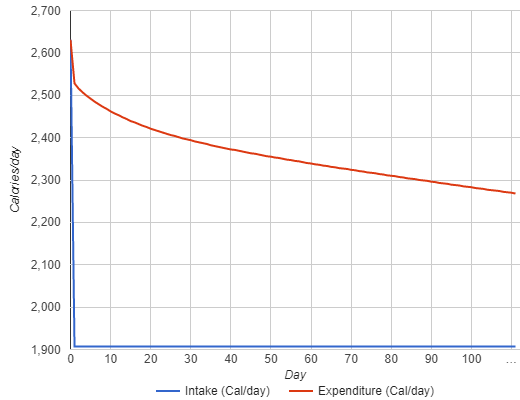
In past contest preps, Eric has reported going as low as 1400 calories per day. This constant necessity to continue to decrease calorie intake to lose fat, combined with the very low body fat, leads to many of the adverse symptoms that competitors experience as they get very lean.
Not All Deficits Are Created Equal
The situations described are ones of low energy flux. This is where you have an energy deficit (let's say a 500 calorie deficit), but it's established with a low calorie intake and low energy expenditure (due to the loss of body weight, NEAT, and metabolic adaptation). For example, a 1500 calorie per day diet combined with a 2000 calorie per day energy expenditure is an example of a 500 calorie deficit achieved via a low energy flux. Contrast that with a 2500 calorie per day diet and 3000 calorie per day energy expenditure, which is also a 500 calorie per day deficit, but achieved via a high energy flux.
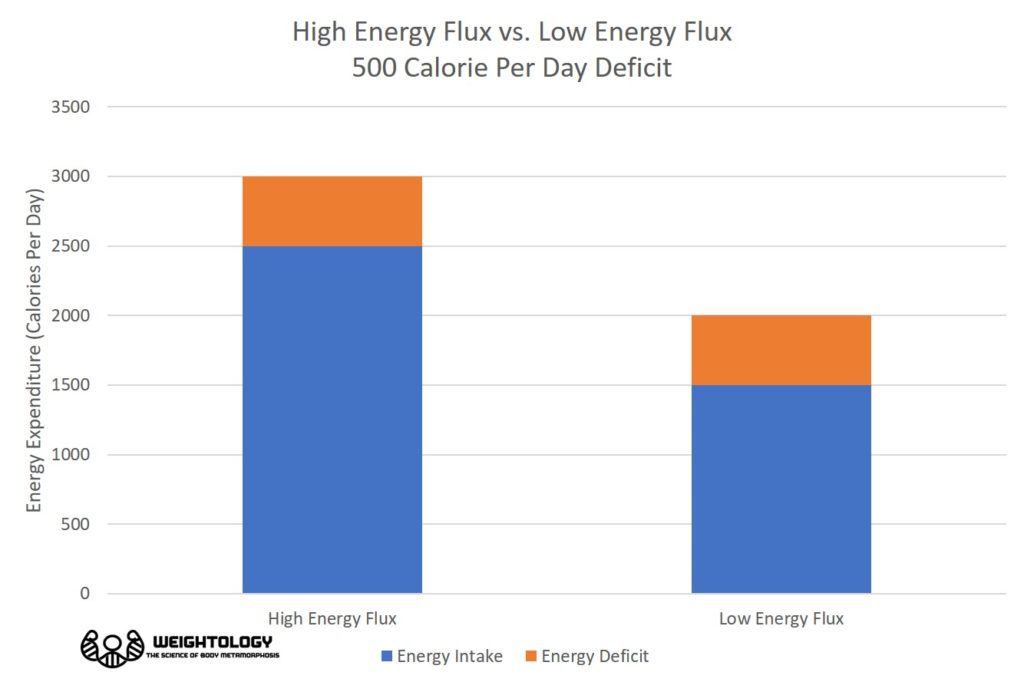
There is evidence that your body's ability to naturally regulate its body weight is most effective in states of high energy flux, rather than low energy flux. High energy flux may protect against some of the metabolic adaptation that occurs with weight loss, and may reduce sensations of hunger. For example, endurance athletes who establish an energy deficit through exercise while maintaining a higher calorie intake have a higher resting metabolic rate compared to untrained subjects in a low energy flux condition. Older adults have a lower resting metabolic rate and lower muscle sympathetic nervous system activity when in a low energy flux state compared to high energy flux state. Following weight loss, obese subjects had a higher resting metabolic rate and reported less hunger and more fullness in a high energy flux condition versus low energy flux condition, despite both conditions being in energy balance. Low energy flux also predicts future increases in body fat.
This data suggests it is better to establish a deficit with a higher energy expenditure and higher calorie intake, rather than lower energy expenditure and lower calorie intake. However, dramatically increasing energy expenditure in physique and bodybuilding competitors to allow for an increase in food intake often means increasing cardio. As mentioned earlier, doing high volumes of cardio may cause interference effects with building or maintaining muscle, as well as increase the risk of overtraining. Weighted apparel provides an alternative, allowing for an increase in daily energy expenditure in a very low intensity fashion, with no need to increase exercise volume. Weighted apparel is essentially a tool to increase NEAT. However, rather than increasing NEAT by increasing step counts and other movement, you are increasing the energy cost of the movement you are already doing. Weighted apparel allows for a higher calorie intake and higher energy expenditure, i.e. a higher energy flux.
Use the "Gravitostat" to Your Advantage
For a long time, the only known regulator of fat mass was the leptin system. I have discussed leptin before in previous research reviews. Leptin is a hormone produced by your fat cells. It gives signals to the brain to regulate appetite and energy expenditure. As you lose fat, your fat cells produce less leptin. Less leptin signals the brain to increase food intake and decrease energy expenditure.
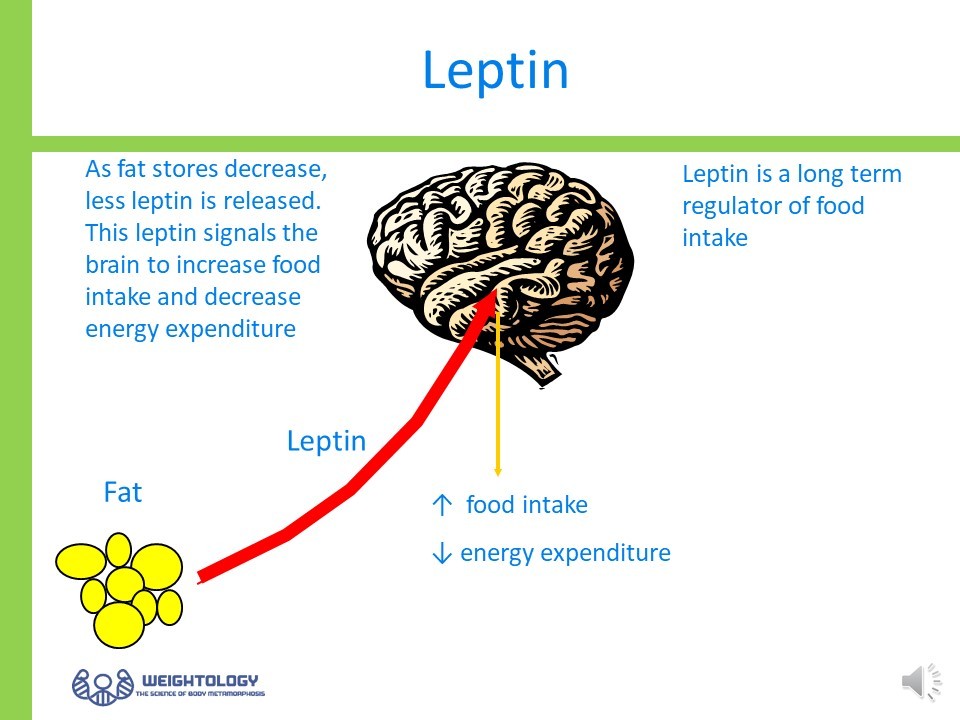
The decline in leptin acts as a starvation signal. In fact, it's likely one of the primary mechanisms behind the increased appetite during contest prep, as declining leptin has a stronger effect on lean versus obese individuals.
Weighted Apparel in Rodents (Sort of)
Recently, evidence has emerged that there is a mechanism to regulate body weight that is independent of leptin, which has been coined the "gravitostat". In this study, scientists implanted weights into the abdomens of obese rodents (similar to adding weighted apparel in humans). The rodents spontaneously lost body weight compared to controls.
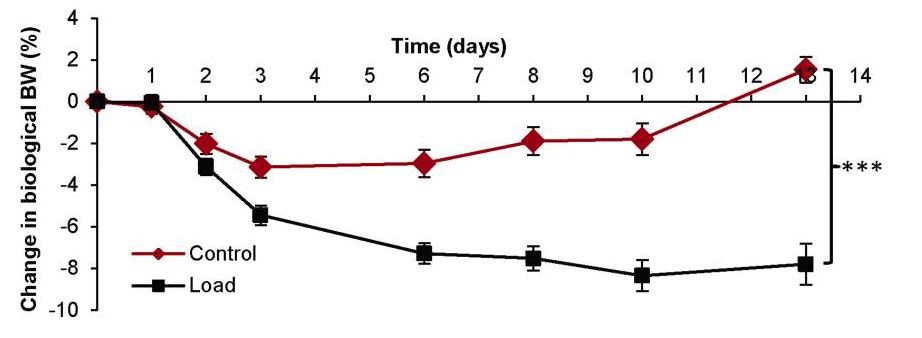
At the end of the experiment, total body weight (biological weight + weight of the implants) was similar between the loaded animals, and the control animals who had no implants.
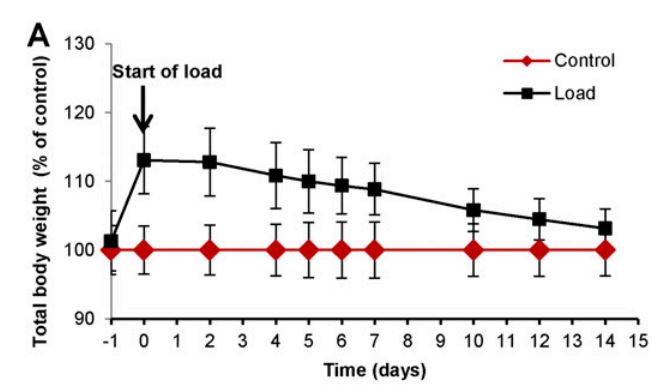
Approximately 80% of the increased loading was counteracted by a reduction in biological body weight.
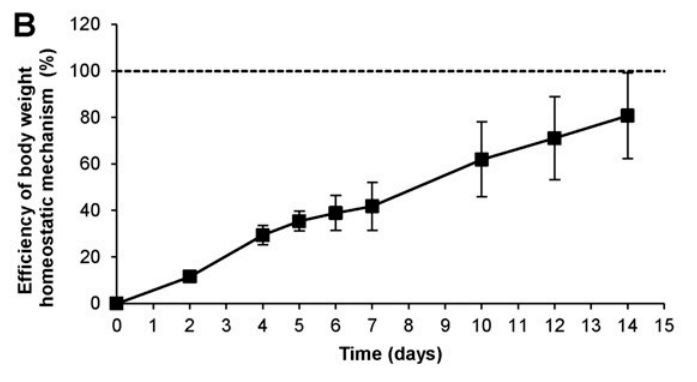
The biological weight loss in the loaded animals was accompanied by a decrease in body fat.
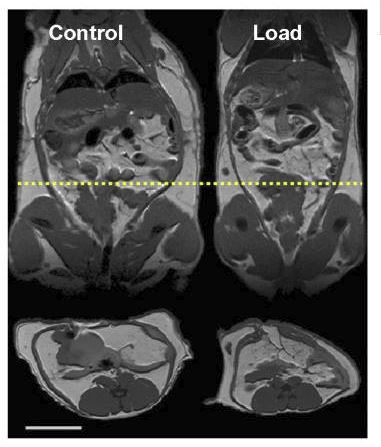
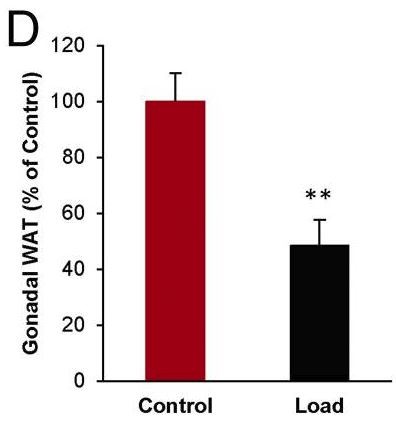
There were no significant differences between the loaded animals and control animals in Uncoupling Protein 1 (UCP1, a protein that generates heat) in brown fat, oxygen consumption (a measure of energy expenditure), respiratory quotient (a marker of how much oxygen goes towards fat burning vs. carbohydrate burning), or physical activity (determined by breaks in laser beams in the cages).
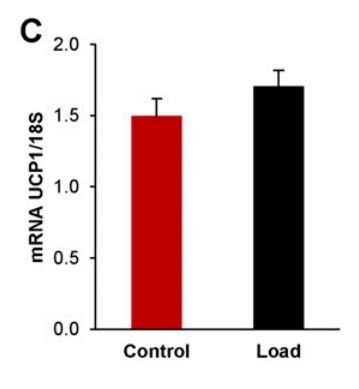
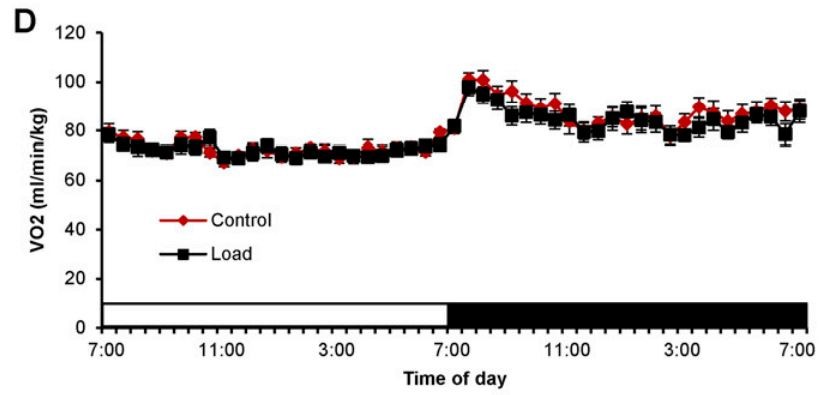
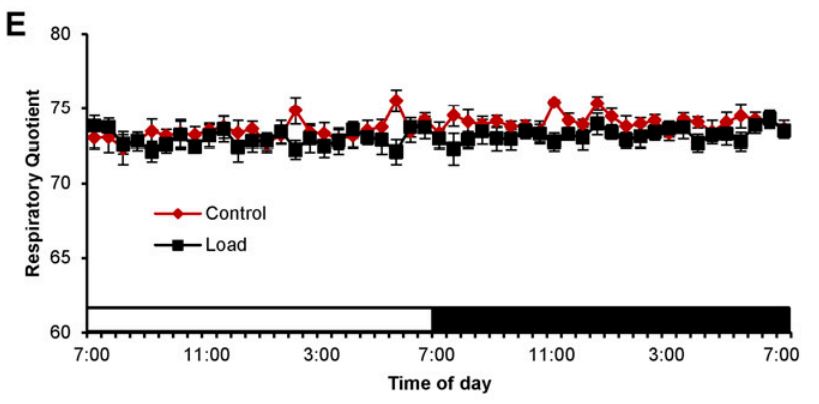
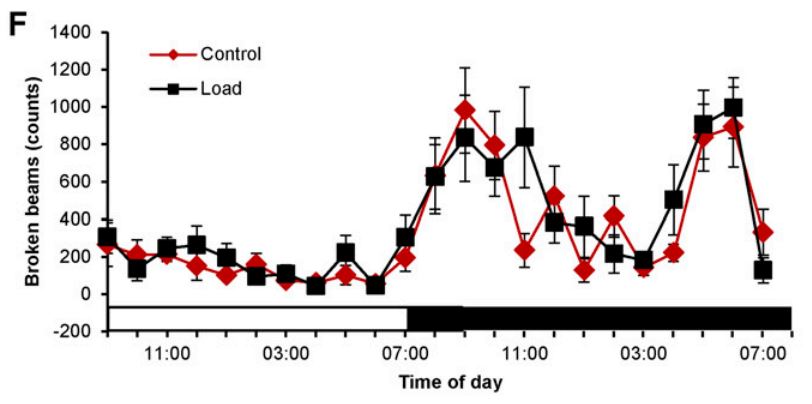
Thus, the additional fat loss in the loaded animals was not due to an increase in energy expenditure. Rather, it came from a decrease in food intake, both in terms of percentage of body weight and grams per rodent per day.
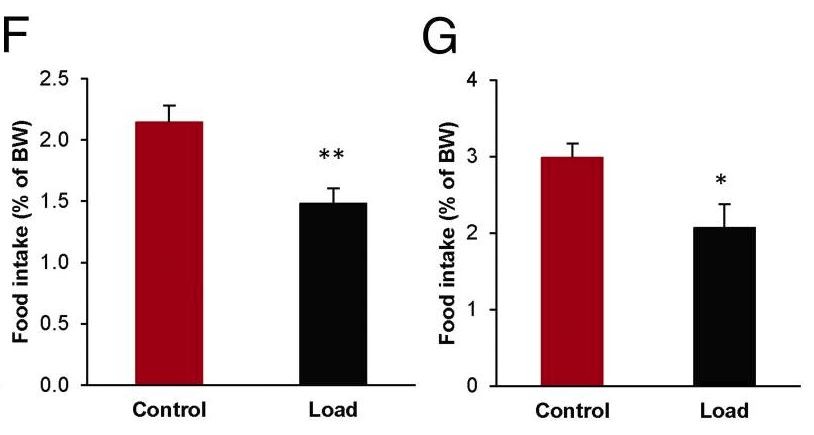
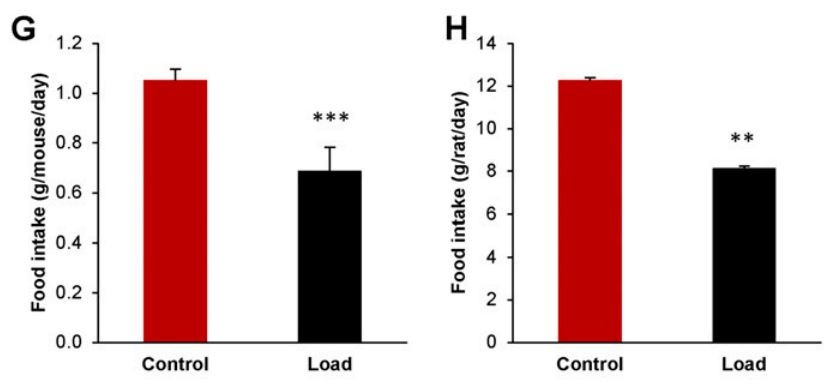
This indicated there was a decrease in appetite in the rodents, proportional to the added weight. However, paradoxically, this decrease in appetite came despite a decrease in leptin.
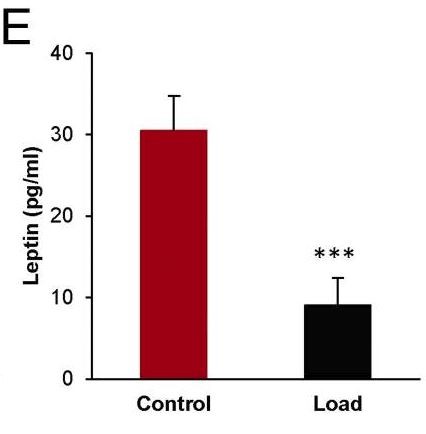
This demonstrates that there was a system to regulate body weight that was operating independently of leptin, because normally a decrease in leptin would be associated with an increase in appetite. If this also happens in humans (which is a big "if", as there's currently no human research), it would suggest that the use of weighted apparel may be an effective tool to counteract the increase in appetite that typically occurs during fat loss and contest prep.
The researchers then took some control rodents, and fed them the same amount of food as the loaded rodents ("pair fed"). The loaded rodents were eating ad libitum (as much as they felt like eating), while the food intake in the pair-fed controls was managed so that it would be the same as the loaded rodents. The two groups of rodents lost similar amounts of body weight.
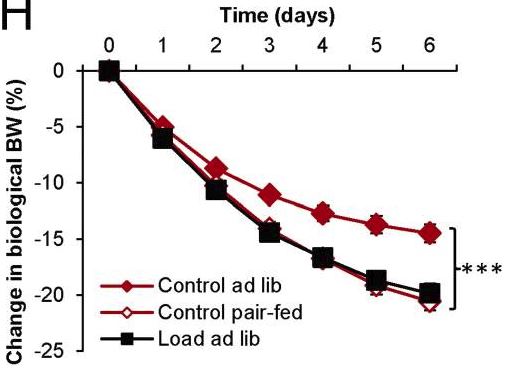
This provided further evidence that the decrease in body weight in the loaded animals came from decreased food intake.
The scientists then used an alternative loading procedure, where they implanted weighted capsules under the skin on the back of the rodents, rather than in the abdomen. The results were the same, with a decrease in biological body weight in the loaded rodents.
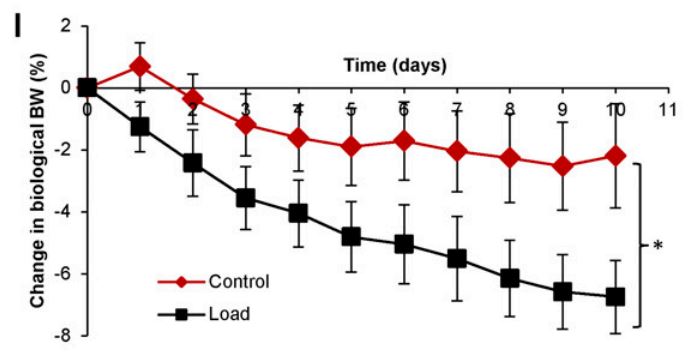
Removal of loading resulted in an increase in body weight and body fat, with no change in muscle mass.
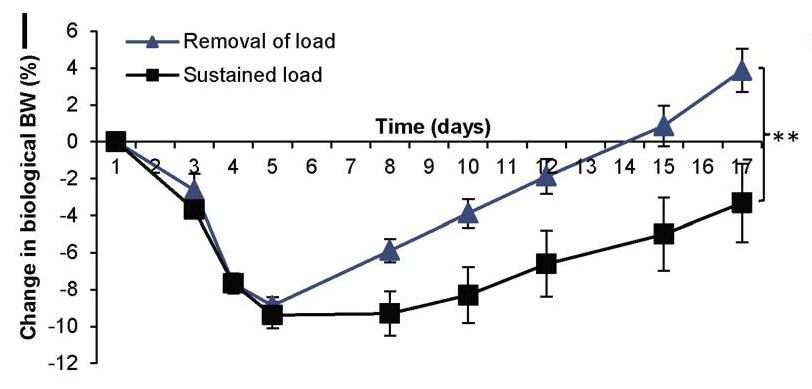
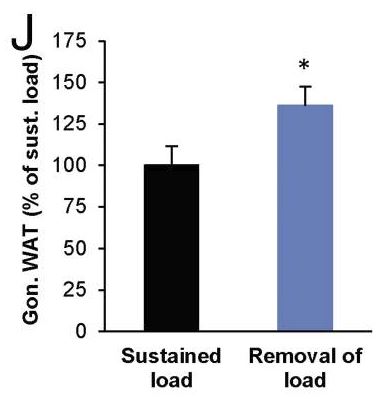
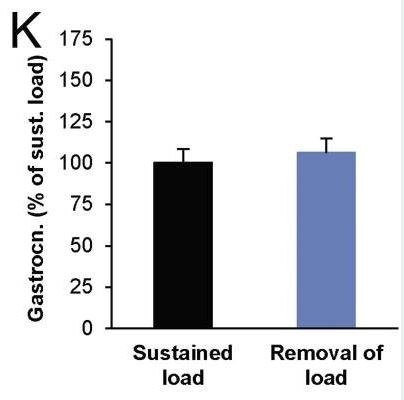
The impact of loading continued in a longer-term, 49-day experiment (remember that both groups are gaining weight over time because rodents grow over time). Biological body weight was significantly lower in the loaded rodents compared to controls.

More Evidence That the "Gravitostat" Operates Independently of Leptin
To further test whether the "gravitostat" operated independently of leptin, the researchers implanted loaded capsules into leptin-deficient obese (Ob/Ob) rodents. The same effects were seen; the loaded rodents experienced a decrease in biological body weight compared to the controls.
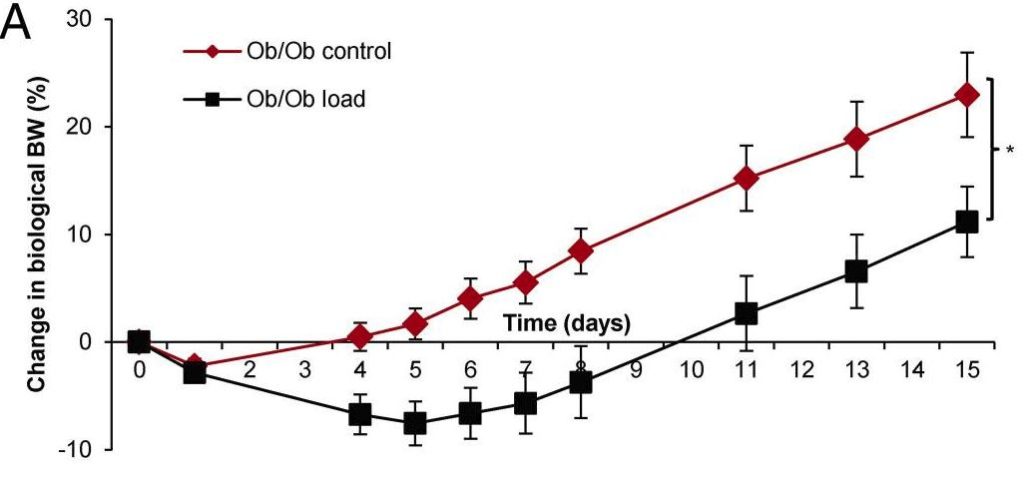
The researchers then divided rodents into 4 groups. Two of the groups were loaded, and two were controls. In both cases, one of the groups had leptin injected, while the other had saline injected. In both cases, injection of leptin caused a decrease in body weight and body fat. As you can see, this was in addition to the effect of loading, as both load groups had lower body weight than unloaded controls, but injection of leptin in both cases caused a further decrease in weight. Muscle mass did not change in any case, indicating the effects on body weight were due to effects on body fat. This further demonstrates that the "gravitostat" operates independently of leptin, and it functions to regulate body weight through regulating body fat, not muscle mass.
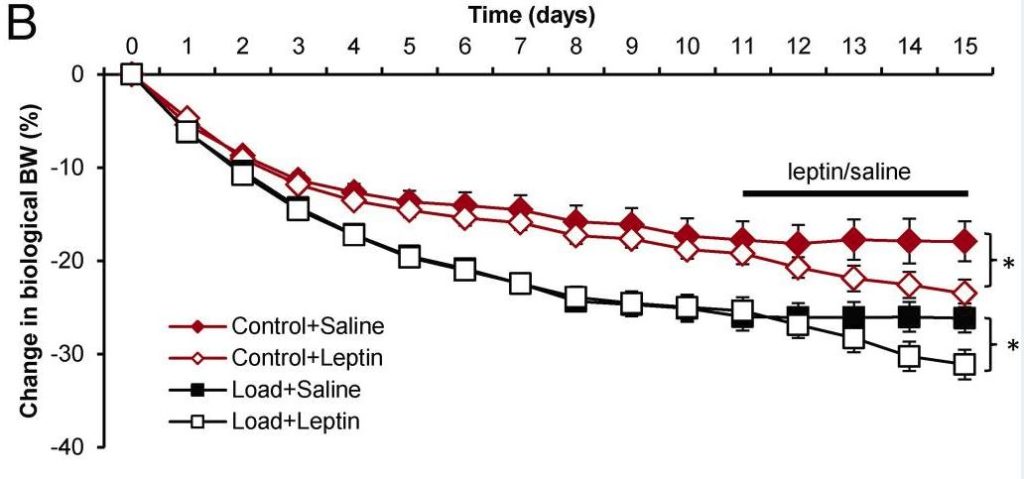
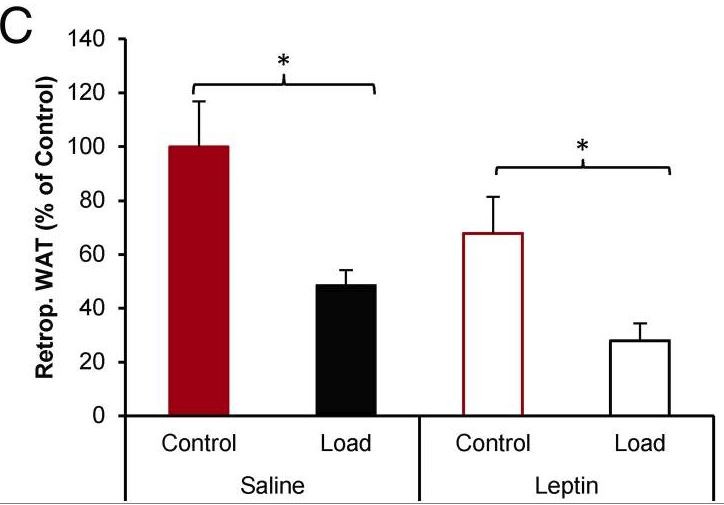
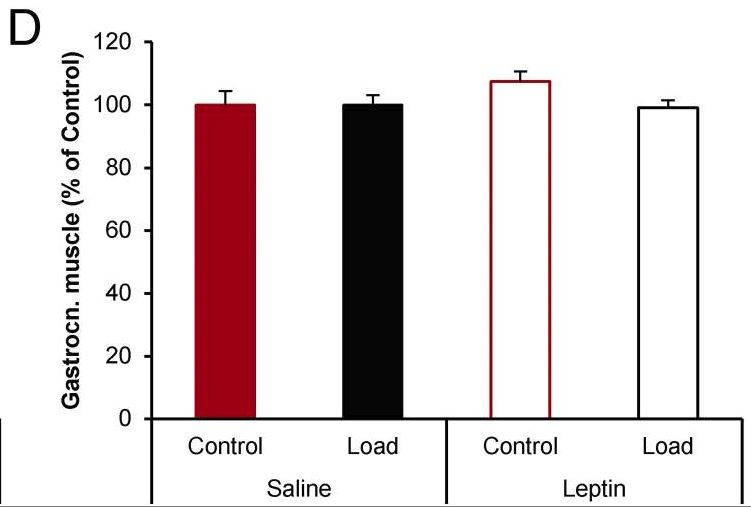
The preservation of gastrocnemius muscle in the loaded conditions also brings up another possible benefit of using weighted apparel. All of the weight loss in the rodents came from body fat; the additional loading helped preserve gastrocnemius muscle as they lost weight. This suggests that weighted apparel may help preserve muscle of the lower extremities during contest prep. This matches with Eric's experience, where he reported maintaining his squat strength and quad size better than he has during past preps.
Interestingly, the loaded rodents showed increased expression of Agouti-Related Peptide (AgRP) and Neuropeptide-Y (NPY), which are hunger-promoting proteins.
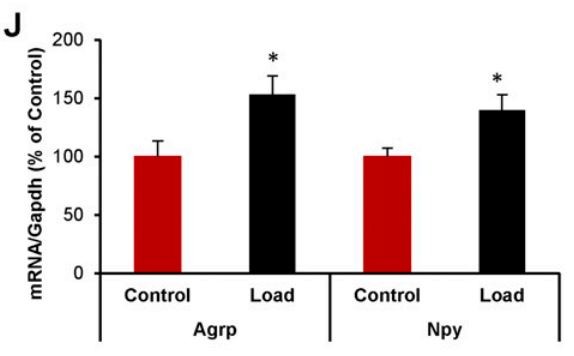
Despite this increase in AgRP and NPY, the rodents showed decreased food intake. This again suggests that the "gravitostat" operates independently of other body weight regulation mechanisms, and may even override the body's efforts to compensate for weight loss by increasing hunger-related proteins.
The "Gravitostat" Operates Via The Bone
Osteocytes are bone cells, and they can sense loading on bone to stimulate increases in bone density. The researchers decided to examine whether this sensing of increased bone load is responsible for the actions of loading on body weight. Loading had no impact on body weight in osteocyte deficient rodents.
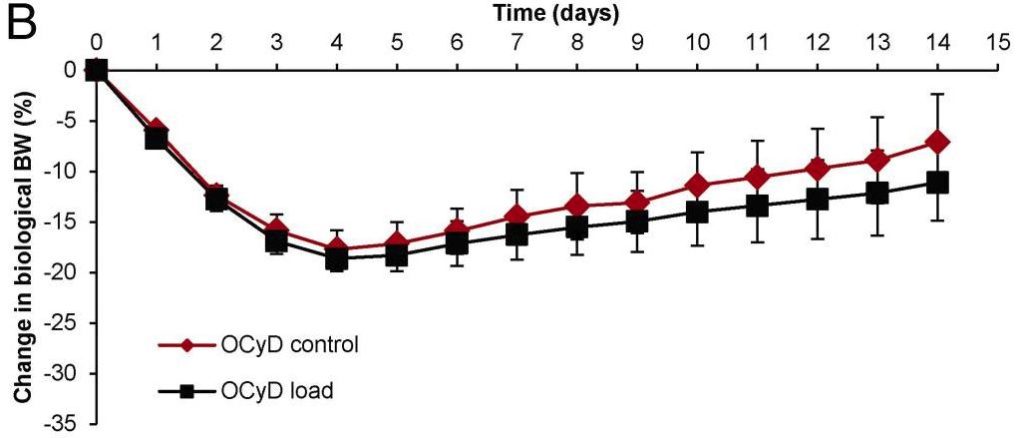
Loading resulted in a decrease in body fat in control rodents, but not in osteocyte-deficient rodents. Muscle mass was not affected, again indicating the system impacts body weight by regulating body fat.
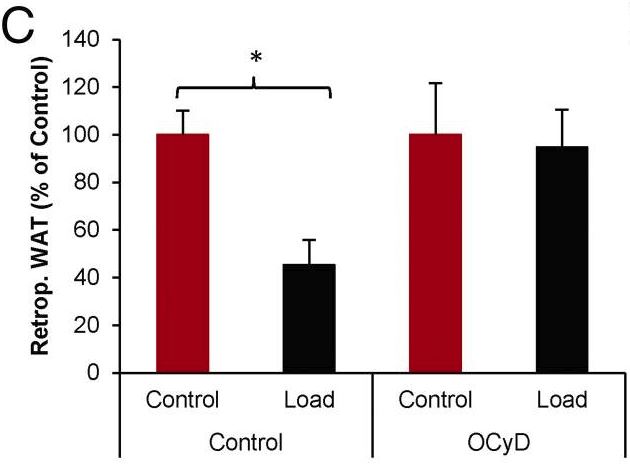
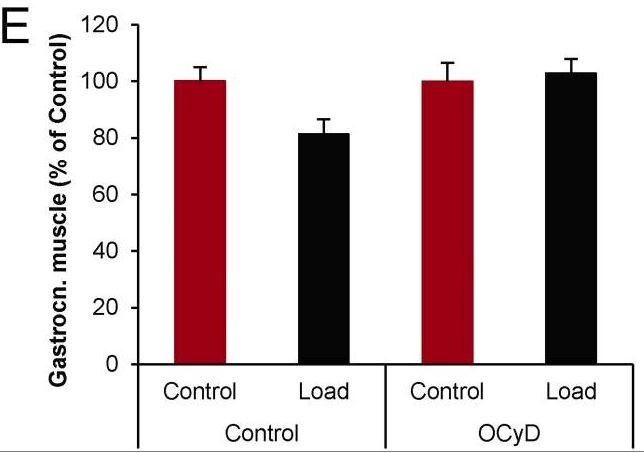
Overall, this data indicates that bones may operate to regulate body weight and body fat by sensing load, and this operates independently of leptin. Increased loading on bone is sensed by osteocytes, which sends feedback signals to the brain to reduce food intake. This, in turn, leads to a decrease in body fat.
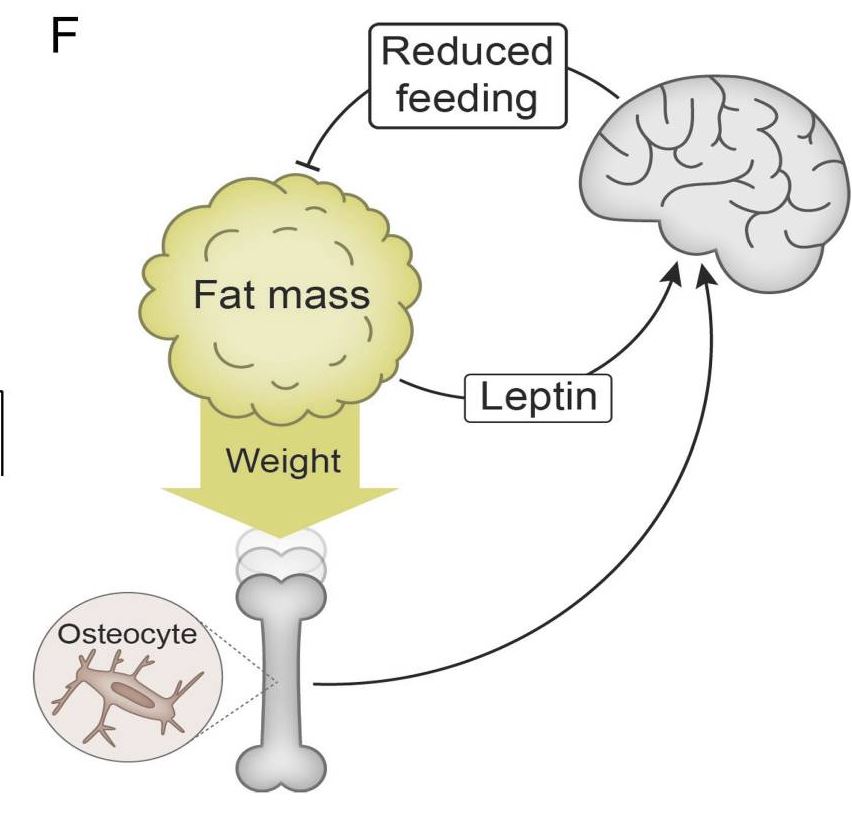
Thus, one of the ways that weighted apparel might help with contest prep is by maintaining load on the bones while you lose weight. This bone loading may then help create feedback signals to prevent the typical large increase in appetite that occurs with fat loss. This brings up an important caveat with the use of weighted apparel, though. Since it appears that loading seems to work by stimulating the "gravitostat" in the bones, this would imply that weighted apparel might not be as effective for people who spend a lot of their day sitting (as there is no loading on the lower extremities). Eric Lee Salazar worked in his gym most of his day, and was standing and ambulating. Thus, weighted apparel likely will work best when used in conjunction with frequent standing/walking. Individuals confined to desk jobs who are not able to get up and walk around much may not get the same benefits out of the use of weighted apparel.
This research also brings up a possible benefit to the use of standing desks. Standing desks have become quite popular in recent years. People have often used them to try to increase NEAT; however, the research indicates they may not be very effective for improving NEAT. Still, there may be benefits to their use in terms of maintaining loading on the lower extremities, which may then improve appetite regulation. For this to be truly effective, it is important that individuals not compensate for increased standing during the day by sitting more during non-working hours, as has been shown to be the case in some research.
The Limits of the Gravitostat
The research does suggest there may be limitations to the effectiveness of the gravitostat as one gets leaner. In this study, obese rodents showed a large decrease in biological body weight with the addition of load, while lean rodents only showed a small decrease that was not statistically significant.
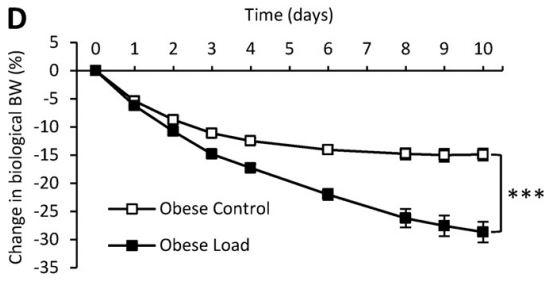
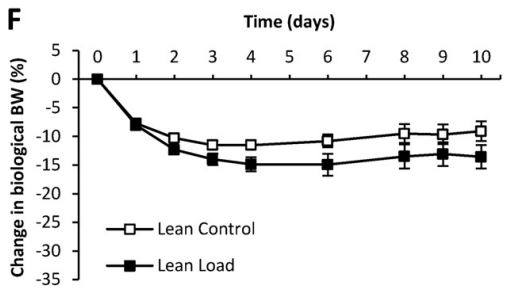
In this study, lean mice were implanted with pellets of 1, 2, or 3 grams. There was a dose-response effect of the added weight, with the lean mice losing more biological body weight and consuming less food with the greater pellet weight.
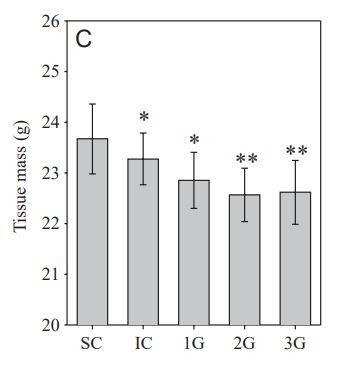
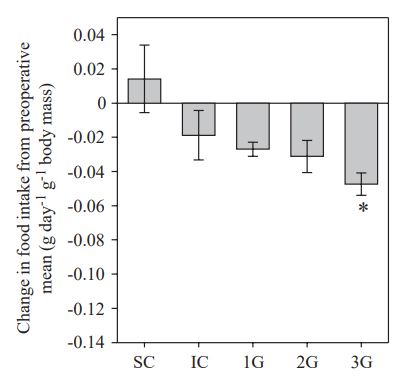
This study showed that the gravitostat did work in lean mice, but there appeared to be a limit to its effectiveness. There was no further decrease in weight when going from the 2 gram to 3 gram pellet. Also, none of the animals lost more than 1.5 grams or approximately 7% of their original body weight. One interesting thing about this study is that, when the pellets were removed, the mice regained weight back to their original starting weight. However, within 12 days of implant removal, the mice lost weight again, and ended back at the weights they were at before implant removal. This suggests that adding the weight altered the "settling point" for these animals. Keep in mind, though, that this is just one study. Whether this can be replicated, or whether it occurs in humans, is unknown. More research is obviously necessary.
Practical Application and Limitations
OK, so you're interested in using weighted apparel for your contest prep. How do you go about it?
- Start your diet as you normally would. Begin with a small deficit that will lead to a weight loss of 0.5 - 0.7% per week, as this is optimal for lean mass retention. Do not use any weighted apparel at the start.
- After about 4 weeks, add weighted apparel to bring your artificial body weight back to its original or higher. START SMALL. For example, do not start with a 50 lb vest; it will be too difficult and you will feel too much fatigue trying to wear it through the entire day. Eric started with a 12 lb vest. There are many options available; check out some of the available vests on Amazon. There are also adjustable versions that allow you to add or remove weights. The most ideal adjustable ones are very thin and can likely be worn under clothing, although they can be more expensive.
- When you first start wearing the vest, it may take a few days to get used to. You may get some slight fatigue or burning in areas such as your traps. This will eventually go away. This is why it's important to start small.
- For the apparel to work, you need to wear it most of your day. Eric wore his 90-95% of his waking hours. You also need to combine it with frequent standing and walking to take advantage of the potential gravitostat effect. Eric was averaging just under 10K steps per day.
- You do not need to add additional cardio as you lose weight. Other than weight training, keep your activity low intensity (like walking).
- Every 4 weeks or so, add more weighted apparel as you lose weight to approximate the weight you've lost. You can go for a heavier vest, or add more weight to the vest if you're using an adjustable vest. Aim for keeping your artificial weight the same or higher than your original starting body weight.
- Keep calorie intake the same through the prep. If weight loss stops despite adding more weighted apparel, then you can slightly reduce calorie intake further, or increase steps and activity. Remember, though, to keep any reductions in calorie intake small if you go that route. The aim is to maintain a high energy flux, and avoid a very low calorie diet. Thus, in most cases, adding more walking will work the best. You can also try adding more weight to your weighted apparel.
- Continue to do this all the way until contest time.
- Once the contest is over, there are two ways you can revert back to your original body weight. First, establish your maintenance calorie intake for your original starting body weight (or whatever weight you want to return to). Increase your calorie intake to that maintenance level. You can then simply stop wearing the apparel, and your body weight will revert back to the weight you want to be at. If you want to regain less quickly, a second option is to slowly remove the weighted apparel over time while consuming the maintenance calorie level. For example, if you added weight every 4 weeks, then you will remove weight every 2-4 weeks while keeping calorie intake constant.
This approach to prep, while very effective, is not without limitations.
- It may not be a practical approach for some people. Depending upon the type of vest you wear, it may be bulky, awkward, or uncomfortable to wear around. Some people may have work situations where they are unable to wear such apparel at their jobs.
- Some of the sleeker, thin vests can be very expensive (>$200).
- The approach may not be effective for someone who spends most of the day sitting, like at a desk job. Standing desks can help with this if you have access to one. However, if you're not used to standing desks, don't simply start standing 6-8 hours a day. Since you're not used to it, you will get a lot of fatigue, and may end up compensating by sitting more during non-working hours. Slowly increase your standing time over days and weeks to allow yourself to adapt.
- This approach is meant for competitors who are temporarily losing weight for a contest. It will likely not work for people from the general population, because those people are looking to maintain their weight loss over the long term. This would require wearing weighted apparel indefinitely. While one rodent study showed that the use of weighted apparel lowered the settling point for body weight, it was just a single study. The study has not been replicated, and we don't know if the same thing would happen in humans even if it does happen in rodents.
- While the science supports the use of weighted apparel, there is no guarantee that your experience or results will be similar to Eric's.
If you're looking to get an edge on your contest prep, and you are able to practically make it happen, then weighted apparel are worth a try. It may give you the following advantages:
- Reduce metabolic adaptation to fat loss
- Protect against large increases in appetite during contest prep
- Allow you to diet on higher calorie levels
- Help preserve muscle in the lower extremities during dieting
- Prevent the need for excessive cardio during contest prep
- Limit the need to constantly reduce calories as body weight goes down
- Reduce negative symptoms that people typically experience during prep
The use of weighted apparel has many advantages with little downside. Obviously we need more human research. Ideally, we would have studies comparing competitors who use weighted apparel during prep to competitors who do not. We also need studies looking at how the use of weighted apparel impact appetite, energy expenditure, hormones, and subjective feelings of well being during fat loss. It's a strategy with a lot of potential.



Hello James I am wondering could this be used as an additional way to bulk. For example suppose you take a lifter at 15 percent bodyfat at 90kg. If he bulked to 100kg he would be stronger at his lifts. But suppose he put on a weighted vest throughout the day wouldnt his body adapt to the additional load just like a fat person would I noticed fat people tend to have big calves from carrying that weight around all day. We know leverages aside that mass moves mass and a bigger guy can lift more. Suppose that guy wore… Read more »
I guess it’s theoretically possible but would probably only impact a small selection of lifts
Similar to Justin’s question, I struggle to keep fat off when I try to increase calories, even slightly for muscle and strength improvements, would this approach work for this scenario?
Hypothetically it would work.
I know we’re talking in terms of contest prep here, but is there any reason this methodology couldn’t be applied to a typical family man trying to get and stay “lifestyle lean” on a cut? Largely to remain as energized as possible for family and work life.
Yes it could work in those situations as well
Jogging places a higher load on the bones than daily activities. Do you think the gravitostat could be stimulated just by frequent weighted vest jogging?
No because unless you’re jogging most of the day it won’t be enough stimulus